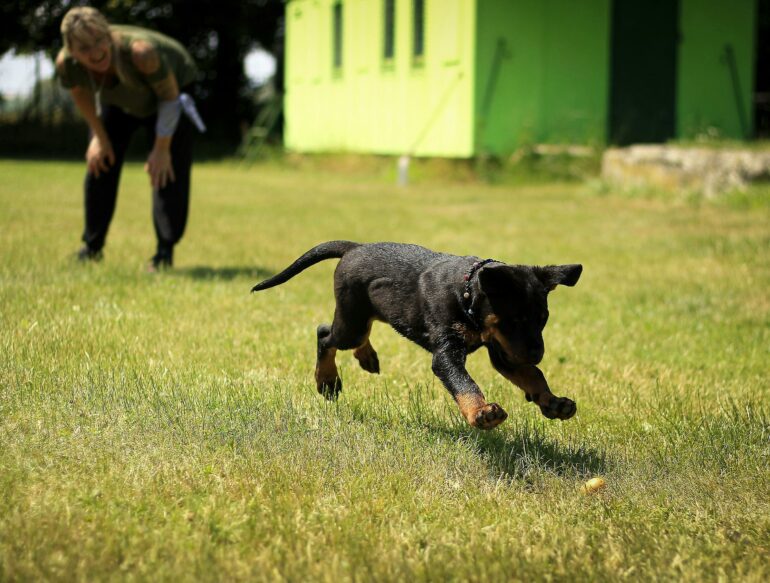While many dogs eagerly respond to food rewards, there are other dogs who may not show much interest in dog treats. This can be a source of frustration during training sessions.
In this comprehensive guide, we'll explore alternative approaches to training dogs that aren't motivated by food, ensuring a successful training experience for both you and your furry friend.
Understanding your dog's lack of enthusiasm for treats is the first step in tailoring an effective training strategy. Factors such as temperament, health issues, a distracting environment or a general disinterest in food can contribute to this behavior. Once you understand why your dog isn't motivated by food rewards, you can explore alternative methods to train them effectively.
Address Health Concerns
Before proceeding with training, it's essential to rule out any underlying health issues that may be causing your dog's disinterest in food. Consult with your veterinarian to ensure that your dog is in good health and not experiencing any dental problems, gastrointestinal issues or other medical conditions that could affect their appetite. Addressing any health concerns will improve your dog's overall well-being and make them more receptive to training.
Gradual Exposure and Desensitization (Optional)
If your dog has a history of trauma or anxiety, they may be hesitant to accept treats or rewards initially. In such cases, it’s crucial to proceed with patience and understanding. Gradually expose your dog to the training environment and desensitize them to any triggers that may cause fear or stress. Start with short, low-pressure training sessions in a familiar and comfortable setting, gradually increasing the duration and complexity as your dog becomes more comfortable and confident.
Test High-Value Rewards
If your dog appears uninterested in standard dog treats, consider introducing higher-value rewards before completely ruling out food as a motivator. Special treats reserved exclusively for training can capture your dog’s attention and establish positive associations with training sessions.
Experiment with different high-value rewards such as:
- Roast chicken
- Smoked salmon
- Cheese
- Ham
These treats are often more enticing to dogs and can serve as effective motivators during training sessions.
Utilize Mealtime as Training Opportunities
For dogs that are not motivated by treats, mealtime can serve as an excellent training opportunity. Instead of feeding your dog from a bowl, use their regular kibble as training rewards. This not only ensures that your dog is getting the nutrition they need, but also helps them associate training with positive experiences and reinforces good behavior during mealtime.
Identify Alternative Rewards
For dogs unresponsive to treats, experimenting with alternative rewards is vital. Every dog is unique, so discovering what motivates your furry friend is essential.
Popular alternative rewards include verbal praise, petting and physical touch, fetch, tug of war and chasing/playing. Once you identify what your dog finds rewarding, integrate it into your training routine.
Incorporate Interactive Play
Dogs that find play more rewarding than treats benefit from integrating interactive play into their training. Utilize toys like tug ropes or fetch toys as rewards for executing commands. This engages your dog physically and strengthens the bond between you and your furry companion. Interactive play adds an element of fun to training sessions and keeps your dog motivated and engaged.
Implement Clicker Training
Clicker training can be particularly practical for dogs indifferent to treats. With its distinct sound serving as a marker for correct behavior, the clicker helps reinforce desired actions. Start by charging the clicker by hand-feeding your dog their dinner and pressing the clicker before each mouthful.
If your dog will allow it, you can continue to charge up the clicker by feeding your dog high-value treats.
Once your dog associates the clicker with food, integrate it into your training routine as a reward signal. Consistent hand-feeding and clicker charging, done at least once a week, reinforce positive behavior and help maintain your dog’s interest during training sessions.
Focus on Positive Reinforcement
Regardless of the reward type, always emphasize positive reinforcement. Shower your dog with praise, affection or the chosen reward when they exhibit the desired behavior. Positive reinforcement strengthens the connection between the action and the reward, encouraging your dog to repeat the behavior. Remember to be patient and consistent in your training approach, and celebrate small victories along the way.
Seek Professional Guidance
If you’re struggling to train a dog uninterested in food rewards despite your best efforts, don’t hesitate to seek professional guidance. A certified dog trainer or behaviorist can provide personalized advice and techniques tailored to your dog’s specific needs and temperament. They can help identify underlying issues, develop a customized training plan and offer support and guidance every step of the way.
By incorporating these additional strategies into your training routine, you can effectively engage and motivate a dog that is uninterested in food rewards. With patience, persistence and a willingness to adapt, you can build a strong bond with your canine companion and achieve success in your training efforts.
Be Patient and Consistent
Training a dog uninterested in food demands patience and consistency. Acknowledge that progress may be gradual and celebrate small victories. Consistent training sessions, positive reinforcement and a calm, encouraging demeanor are crucial components of successful training. By maintaining a positive training environment and being patient with your dog, you can build a strong foundation for obedience and behavior.
In the realm of dog training, flexibility and adaptability are paramount. Recognize and respect your dog’s preferences to pave the way for a more fruitful training experience. By identifying alternative rewards, incorporating interactive play and maintaining a positive training environment, even dogs initially unresponsive to food can become eager learners. With dedication and understanding, you and your canine companion can embark on a rewarding training journey together.





